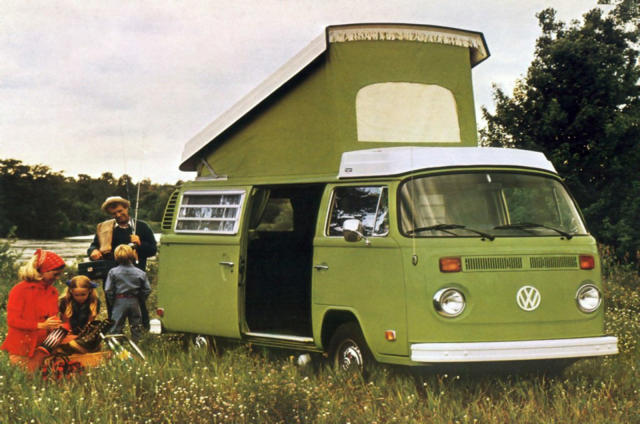Volkswagen Splits screen:
Ben Pon, a Dutch businessman, saw employees moving parts around in a tiny van built on a Beetle chassis while he was touring the Volkswagen factory in 1950. This observation led to the creation of the T1. In 1951, Westfalia, a German coachbuilder, collaborated closely with Volkswagen to develop what would become one of the most well-known and pioneer campervans worldwide.
It had a fully equipped kitchen with a refrigerator and an expanding roof, as well as a radio and clock on the dashboard. The T1 was the go-to camper for the burgeoning hippy movement in 1960 because of its inexpensive operating costs.
Alfa Romeo 35 AR8 Ravello:
Alfa Romeo is primarily known for producing B-road-destroying sports vehicles like the Spider and GTV, but in 1979, the brand-new Fiat Daily van was also promoted as an Alfa Romeo AR8 Ravello. To set it apart, Alfa affixed their recognizable V-shield to the front of the vehicle. Travelers may enjoy a fine dining experience with the two captain's swivel chairs up front that could be turned to face the two seats at the back. A table could then be clipped into place. The table would just be put away at night, and the front and back seats would fold down to provide two single beds.
Dodge Sportsman A100:

Even though it was first available in a van, Dodge would provide a complete camper conversion in 1969 if you approached them with an A100 or A108, which was the longer wheelbase type. Full foam, all-vinyl front bucket seats were included as standard, but purchasers could request a kitchen with an oven and stove, a dining room, a square-patterned vinyl floor, and fold-out beds to accommodate three people. Two-tone paint, big round headlights, lots of chrome accents, and a split windshield completed the look of the outside.
Volkswagen Bay Window:
In 1967, Volkswagen stopped producing the T1 bus to make room for the new Bay Window camper, having produced 1,477,330 buses. Its form was more angular than the T1, with a vent beneath the single windscreen and distinct headlights on its flat front. Additionally, the suspension had a stabilizing bar at the back.
The campers included fold-out gas cookers, tables, beds that slept four, and water-cooled refrigerators. Passengers may enjoy the rural air by sliding open the side door and having the roof lift up like that of the T1.
Dodge Travco:
Older RVs evoke a sense of nostalgia due to their excessive use of chrome, two-tone paint, and unique design elements that are typically absent from contemporary RVs. For the 26.5-foot length available, Dodge offered buyers two different layout options: one featured a larger wardrobe in lieu of a seat that converted to a single bed, with a longer seat at the back that became a double bed; the other option included a separate bedroom with a double bed at the back. Despite the Travco's weight of somewhat more than six tons, its 200 horsepower 5.2-liter V8 engine allowed it to reach a respectably remarkable top speed of 70 mph.
Jeep Gladiator:
A few months after buying a brand-new Jeep Gladiator pickup truck in the 1970s, you suddenly realize how much you regret not getting a camper. You might choose to buy a camper accessory that would be fastened to the pickup's bed in place of selling your vehicle. Tons of wood, 70s-style decor, a separate shower/toilet, and a dinette that could be made into a 50-inch bed were all present inside. Three series options were available to buyers: Matador, Toreador, and Chassis.
GlamperRV Business line:
GlamperRV seized the chance to launch their new business line RV when the world came to a standstill owing to the terrifying Covid-19 pandemic, which caused offices all over the world to close and established home-working as the new standard. It was essentially meant to be an office that people could use from anywhere, separate from their main office. It had a spacious garage area for bikes, a wide central work desk, USB charging ports, 5G mobile WiFi, and a Nespresso coffee maker to power through those long meetings. Customers could choose between a diesel engine producing 140 or 160 horsepower and nine-speed automated transmissions.
Winnebago Brave:
Its flat face, tacked-on headlamps, and steep sidewalls make it one of the most recognizable RV designs. Frequently, their metal facades featured a 'W' livery featuring orange, olive green, red, or yellow striping, in case its hefty appearance wasn't enough to distinguish it from rivals. You could have chosen the longest 28-foot (336-inch) model if you were traveling with a large family, or the basic Minnie Winnie would have been plenty for a romantic getaway for two. Either way, you would have still received an American V8.


